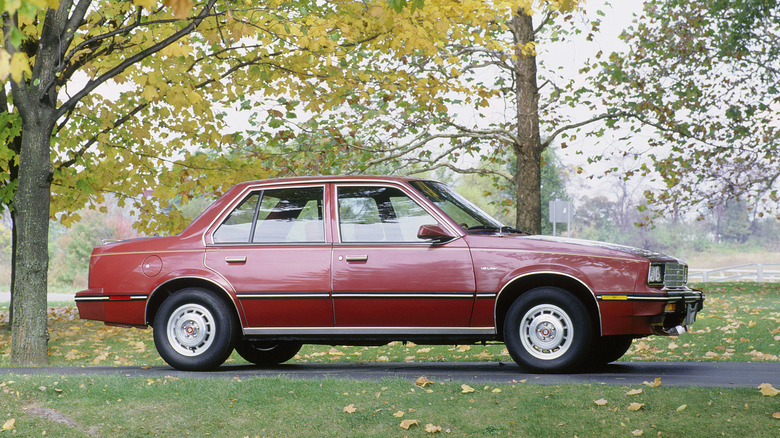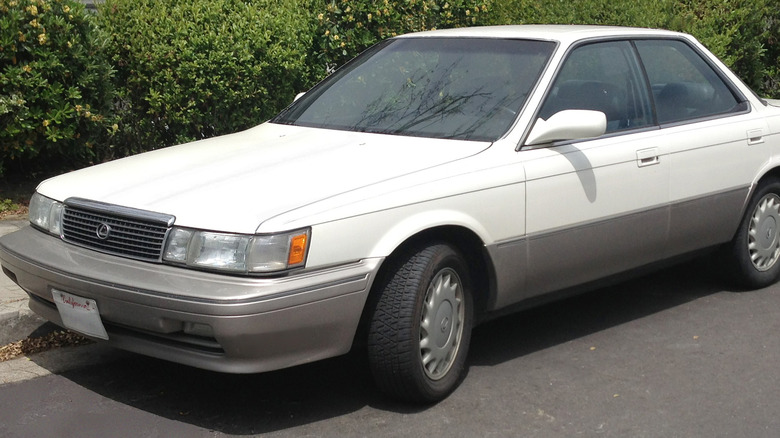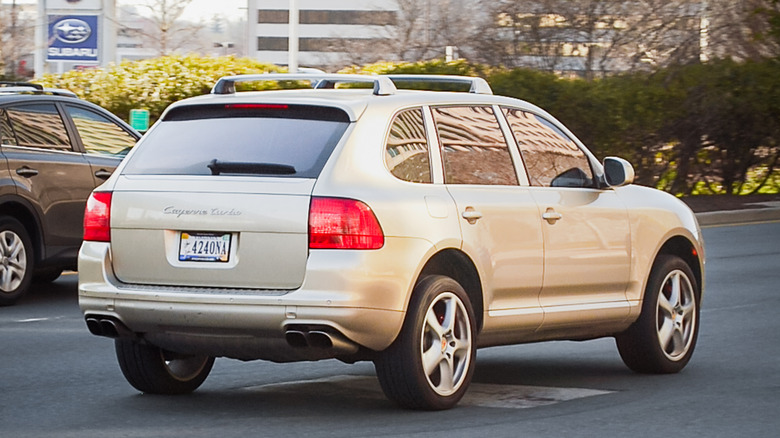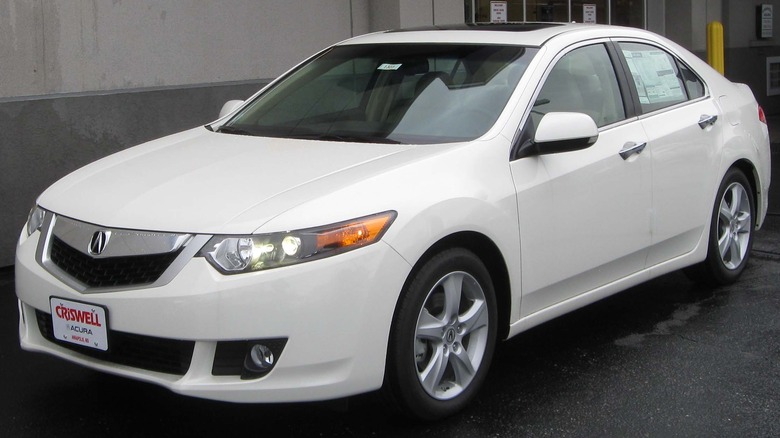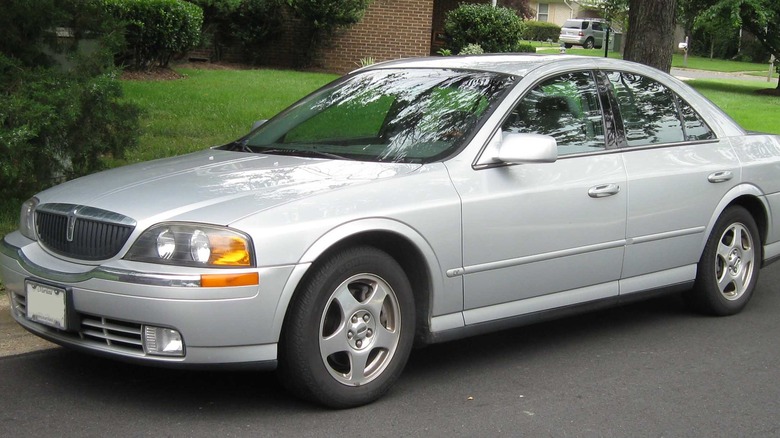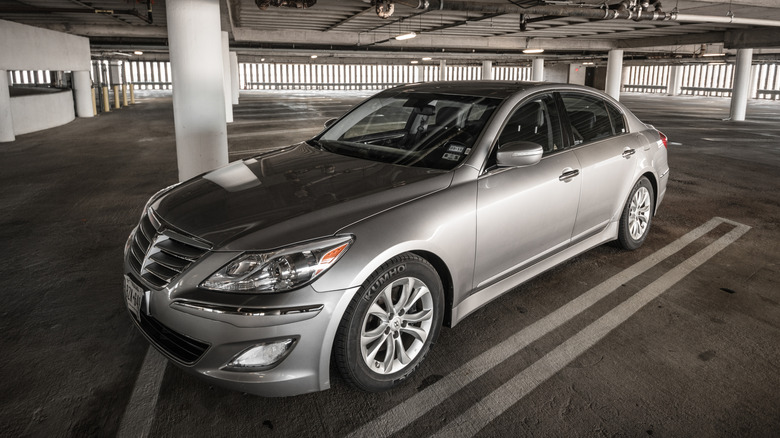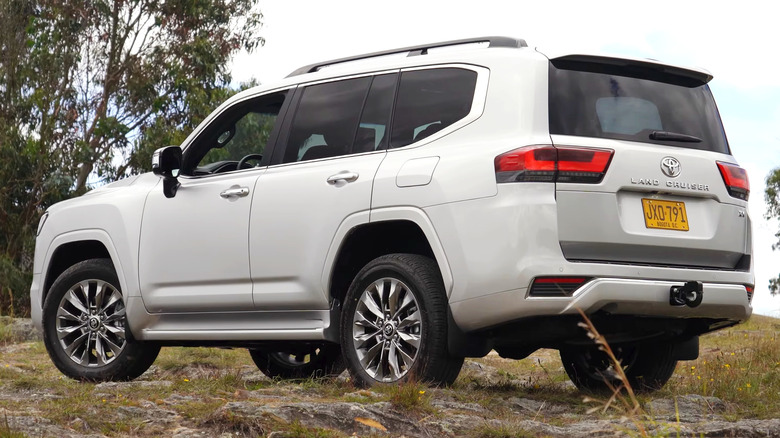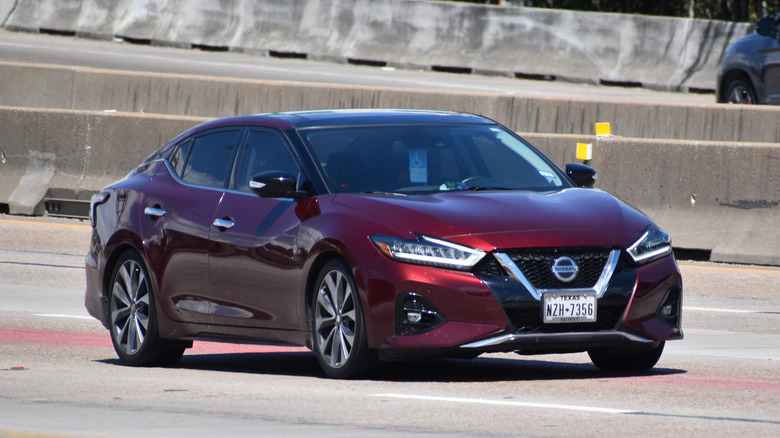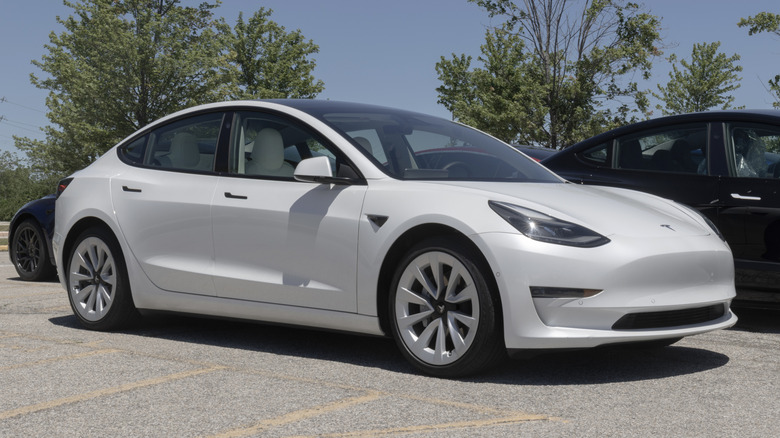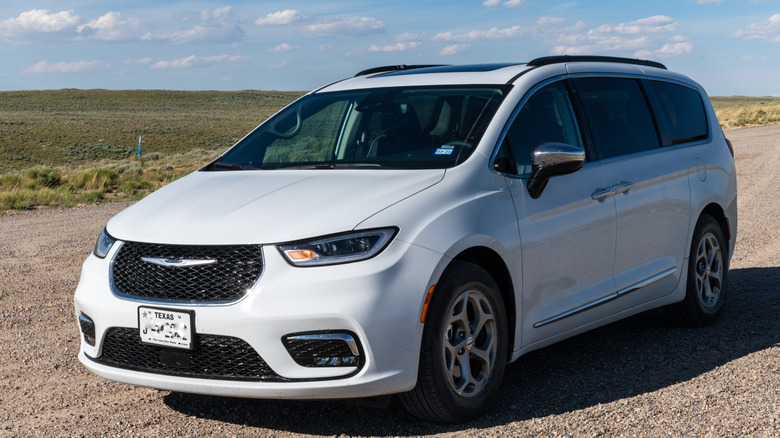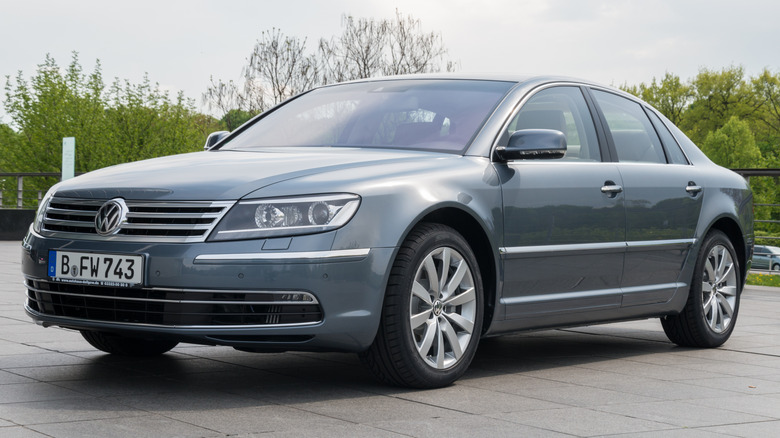10 Expensive Cars That Look Cheap
Some luxury cars shout their elegance and don't try to hide their price tags. Take the Rolls Royce Ghost Series II: Its towering grille is a throwback to an era where the "drag coefficient" was an alien concept. If you can afford a Rolls, you can afford the gas that disappears into the vastness of its 6.7-liter twin-turbocharged V12 engine. The Ghost is for folks who don't have to ask what it costs, and it looks like it. Not only do Rolls drivers not care if their cars look expensive, they prefer it that way.
On the other end of the luxury spectrum are expensive cars which don't really look the part. Call it stealth luxury — a kind that whispers rather than shouts. In some cases, it might not be intentional. Consider the Cimarron from the 1980s, a Cadillac everyone forgot existed, if they're lucky. It looked cheap because it was a re-badged J-body economy car, like a Chevy Cavalier or a Buick Skylark, with a different grille and a few extra standard features.
These days, automakers have gotten better at distinguishing between models, even when they share DNA. For instance, the current Honda Civic and the Acura Integra share a platform and some engine choices, but have noticeably different sheet metal and driving feels. However, some high-end luxury models are intentionally designed to resemble their cheaper showroom siblings, and that's what we're focusing on. Looking "cheap" is subjective, but these following models' window stickers arguably belie their appearances.
1990s Lexus ES 250
The Lexus name and logo only date back to 1990, when Toyota's brand-new U.S. luxury division launched the large and luxurious RWD LS 400, complete with a powerful and silky-smooth V8. The division existed to sell luxury models to an American consumers that associated Toyota with economy cars. However, the LS 400 was pricey for its day, and Lexus needed an entry-level model to introduce car buyers to its lineup. The Lexus ES 250 would become one of the most successful vehicles in Lexus history, but its debut wasn't universally acclaimed.
Some critics felt the ES was too similar to the Camry. This made some sense, as the ES shared a platform and even an engine with the Camry. Normally, comparing a car of that era to the Camry would be high praise, given its legendary reliability and huge sales volume, but the ES carried a higher price tag than its Toyota cousin. MotorTrend labeled the ES 250 the "country club Camry," and car shoppers were left wondering what it offered for the extra money.
The interior told a different story — the ES 250 was outfitted to the same standard as the LS 400, offering a level of luxury and polish that even a top-of-the-line Camry couldn't match. It shared an engine with the Camry, but it was the best engine available in the Toyota model: a 2.5-liter 24-valve V6 producing 156 hp. In 1990, this was quite respectable. Despite the exterior resemblance, sales were brisk.
2003-2010 Porsche Cayenne
Porsche is one of the world's leading sports car manufacturers, but in the 1990s the company was teetering on the edge of bankruptcy. Its entire model portfolio once consisted of variants of the venerable Porsche 911, which evolved over decades into a pure high-performance sports car, but was too expensive for most drivers. Porsche began its climb back to solvency with the Boxster roadster, and to the horror of many, its next mainstream model was an SUV: the Cayenne.
The purists feared a typical SUV for that period: a soft-riding, top-heavy boulevard cruiser that would roll hard when pressed into a corner. Thankfully, the Cayenne was none of those things. Its performance won over many skeptics, and one variant even became one of the fastest SUVs ever made. Porsche's engineers somehow produced an SUV that could genuinely handle like a sports car.
However, the Cayenne was Porsche's first SUV, and its designers couldn't draw on decades of experience for inspiration. Plus, it shared a platform with the Volkswagen Touareg. Today, the first generation of the Cayenne looks plain and chunky. Its tiny tail lights look like they belong on an entry-level economy SUV. Its huge front air intake looks out of place, given the manufacturer's other models at the time were mid-engined or rear-engined cars. Overall, it looked neither aggressive or sporty. When it first reviewed the Cayenne, MotorTrend called it a "basic jellybean with a hood." The model would go on to become a legend, but its earliest version didn't look the part.
2004-2014 Acura TSX
When Acura debuted in 1986, its mission was to compete with German imports like BMW and Audi, which were enjoyed booming sales. From day one, the brand faced the challenge of building out a full model line while convincing American car buyers that Honda could make premium automobiles, even when they sometimes shared platforms with Honda-badged cars. Honda had a terrific reputation — for building economy cars. Luxury cars, not so much.
Acura's success changed a lot of minds. The most luxurious Acura models, like the Legend and the NSX supercar, were an easy sell, but Acura needed lower-end options to anchor its lineup. For the 2004 model year, the entry-level rung on Acura's ladder was occupied by the RSX hatchback coupe. Since that meant there was no longer a compact sedan in the lineup, Acura introduced the TSX sedan. The TSX was based on a global platform that formed the basis for the Accord and other models internationally. There was absolutely nothing wrong with the first-generation model's looks. It was handsome — it looked like a slightly smaller Accord, but it offered a terrific 2.4-liter 200 hp four-cylinder that delivered on its sports-sedan promises.
The second generation of the TSX debuted in 2009 and ditched the clean Accord-like lines, in favor of a much busier style, featuring character lines, bulging fenders, and a grille that resembled a safety razor blade. It was not universally admired. In a 2008 review, TheTruthAboutCars called it "ugly and confused" — not quite understated luxury.
2003-2006 Lincoln LS
By the early 2000s, European and Japanese sedans dominated the entry-level luxury niche. Traditional American luxury car maker Lincoln had always specialized in huge, floaty sedans. When it introduced the LS sports sedan in the 1990s to compete with the imports, the brand followed the philosophy of "If you can't beat 'em, join 'em," basing the car on the same platform as the European Jaguar S-Type. By 2003 it was time for a refresh. The heavily updated LS drew praise for its refinements over previous models, but its styling didn't quite keep pace, in some reviewers' eyes.
First, the improvements: Lincoln boasted of 500 refined components for 2003, resulting in a quieter car thanks to new body sealing and a smoother-sounding engine. The engine was more powerful, too, with the optional 32-valve V8 improving by 28 hp to an even 280. A beefed-up suspension improved the handling. The cabin received more storage compartments and luxury touches like power-adjustable pedals.
But these objective improvements couldn't cover up the fact that the LS rode on an old platform and it looked dated. Lincoln arguably worsened the situation by deliberately going for a family resemblance, creating a style that Car and Driver considered too close to the "antediluvian Town Car." The publication felt the exterior's conventional lines and big bumpers failed to hit the European-style sports sedan aesthetic. It was an old-school American look that ended up just looking old, even when it was new.
2009-2016 Hyundai Genesis Sedan
Hyundai entered the U.S. market in 1986 with the subcompact Excel. This car's exterior was designed by Italdesign's Giorgetto Giugiaro, it was efficient, and most of all it was cheap. The base price was only $4,995 and it sold like hotcakes, establishing Hyundai's reputation as a purveyor of small and economical cars. That proved to be an issue when Hyundai was ready to introduce more upscale models in the States in 2009. It debuted the Genesis sedan, hinting at the "genesis" of a new image for the Korean manufacturer.
The Genesis had much going in its favor. It had a longer wheelbase than a Mercedes E-class. It offered a 4.6-liter, 375 hp V8. The interior was finished in materials befitting a luxury car. All of the most sophisticated high-tech options were available, from a navigation system to a 17-speaker premium audio system. A fully-loaded model came in at around $42,000, which was easily into luxury car territory in 2009.
However, as Hyundai's first real foray into selling a luxury model in America, it lacked a distinctive look that would say, "This is a premium luxury car." A review in TheTruthAboutCars summed it up: After asking what keeps the Genesis from looking like its more established competitors, their answer is, "Nothing at all. Nothing makes it any different, either." The lack of a logo in a class where buyers want their cars to display a premium badge right up front and center, didn't help either. That would have to wait until Genesis split into its own brand in 2016.
2021 Toyota Land Cruiser
Every Toyota Land Cruiser generation since the model's inception in 1955 has provided plenty of off-road capability. Land Cruisers have covered some of the most rugged terrain on earth, from the African Savannah to the rocky American West. The nigh-indestructible build required for those place is why old Land Cruisers are worth a lot on the used market. When Toyota launched the 2024 Land Cruiser, the new model went back to its hard-core off-roading roots.
However, the previous Land Cruiser was the 2021 edition. Make no mistake: the 2021 was a terrific truck. In fact, a review in Forbes magazine called it "the world's best SUV." The reviewer praised its durability, off-road capability, and design, which could carry up to seven people comfortably. Special note was made of the fact that the Land Cruiser is the most likely vehicle in the American market to hit the 200,000-mile mark.
However, the reviewer was honest about the 2021 Land Cruiser's shortcomings, acknowledging its "aging design elements" and outdated styling. Even its interior comes in for criticism for some quirky ergonomics and a mechanical shifter in an era when most other SUVs had electric shifters. The engine was noisy and the steering effort was high. All of this made the 2021 model resemble a used vehicle right off the new dealer's lot. Granted, it resembled a very good used vehicle, but for $90,000 appearances could be deceiving.
2016-2023 Nissan Maxima
The 2016 Nissan Maxima kicked off what would turn out to be the final generation of Nissan's long-time flagship model. 2023 would see Nissan discontinue the Maxima in the middle of the model year amid declining sales and the company's increased focus on electric vehicles. This final version temporarily revived Nissan's self-described "four-door sports car." Motor Week called it "the best Maxima, and the best Nissan badged sedan, we've ever driven." Other reviews praised its 300 hp V6, Zero Gravity bucket seats, and quieter drivetrain than previous models.
Reviewers generally praised the Maxima's exterior, as well. It was a radical departure from the fairly plain previous generation of the model. Very prominent character lines traced the tops of the bulging fenders and rear quarter panels. A dramatically plunging C-pillar created an extreme fastback profile, while the rear quarter windows trailed into a cats-eye squint of chrome and black trim. The interior layout and quality were excellent, and rear-seat headroom was good despite the low roofline.
So where did the problem lie? Like with other models, family resemblance came into play. The final Maxima looked very similar to its less expensive showroom sibling, the Altima. Or perhaps it's more accurate to say that the Altima resembled the Maxima, since it debuted later. It sported many of the same styling cues, including the plunging rear roofline trailing into black trim behind the rear quarter window. Its grille is very similar too, but the rear three-quarter view is the most similar; casual observers would have difficulty knowing which one they were looking at.
2017 Tesla Model 3
After years of building cars like the original Tesla Roadster and the Model S — a Tesla that the NHRA banned for being too fast for its drag racing tracks — Tesla sought to build an electric vehicle priced for mainstream buyers. The Model 3's base price was set at $35,000. However, during its introductory period in 2017, only higher-end models with features like a long-range battery and premium packages were available, starting at prices above $50,000.
For that money, buyers got a very good EV. With the longer-range battery, the Model 3 could travel 310 miles between charges, quite respectable for 2017. Performance was blisteringly fast with a 0-60 mph time of 4.9 seconds. Its minimalist interior looked like modern art. Most buttons and switches were replaced by a touchscreen that pulled double duty as the driver's instrument panel, with a simulated speedometer, turn signals, and other required indicators. Tesla made these instruments seem like an afterthought since the goal is for the cars to drive themselves someday, but for 50 grand, most drivers want a little more luxury in the cabin.
The exterior was handsome in a basic way, but offered some awkward proportions. Road & Track magazine ran an otherwise positive review, but acknowledged that "the roofline looks ungainly from certain angles." The front ditched the vestigial grille of the Model S, but the result is a nose so plain that it looks like something a child might carve from a bar of soap. This car was intended for EV enthusiasts who didn't need a lot of flash.
Chrysler Pacifica
Over the decades, Chrysler discontinued major car brands like DeSoto, AMC/Eagle, and Plymouth. Now Stellantis owns Chrysler, and the venerable American brand is itself in danger of fading away. Its lineup has shrunk to include only two models, different versions of the same minivan platform. The Chrysler Halcyon concept offers hope for the brand's revival as part of an electric car future, but for now, only a minivan platform carries on a century of Chrysler tradition. You could call the Pacifica Chrysler's flagship, but really it's the only ship.
The Pacifica isn't a bad ride, as far as minivans go. It's light-years ahead of the 1980s Chrysler, Plymouth, and Dodge basic-but-roomy family haulers that launched the category. The current Pacifica minivan model was introduced in 2016, not to be confused with the Pacifica crossover SUV that Chrysler sold from 2003 through 2006. The minivan offers a 287 hp V6 with front-wheel drive or all-wheel drive, or a 260 hp hybrid gas-electric drivetrain with front-wheel drive. It offers tons of cleverly packaged interior space and a level of luxury befitting Chrysler's upscale brand image.
However, its exterior hasn't been updated since 2021 and its age is showing. And let's face it: it's a minivan. You can equip it with AWD, a leather interior, rear-seat cameras, and an infotainment screen, but at the close of day, it's still a basic family hauler. Which would be fine, if the fully loaded hybrid model's price didn't reach $61,685.
2002-2016 Volkswagen Phaeton
The Phaeton may be the ultimate example of an expensive car that looks cheap. And it was very expensive indeed, reaching the $100,000 mark during an era when only exotic Italian supercars and hand-built British luxury sedans generally hit six figures. You could even get a Mercedes S-class for less. Volkswagen built the Phaeton between 2002 and 2016, although here in the U.S., we only saw it on sale between 2002 and 2004 — 100 grand for a Volkswagen apparently just didn't make sense to Americans.
It's a shame that the Phaeton was priced out of consideration in the States, because in many regards it was an excellent car. Indeed, we included it on our list of underdog luxury cars that deserved a better fate. It shared a platform with a pair of Bentley models, which no doubt contributed to its sky-high price. The base engine was a 4.2-liter, 335 hp V8, but the real star of the Phaeton lineup was a 6.0-liter, 420 hp W12.
As impressive as the car was, the Phaeton's exterior simply looked too much like far cheaper Volkswagens. A writer for MotorTrend described his first view of a Phaeton in person, saying it "resembles a well-fed Passat." The Passat was a fine car, but few drivers wanted a six-figure sedan that looked like it.
